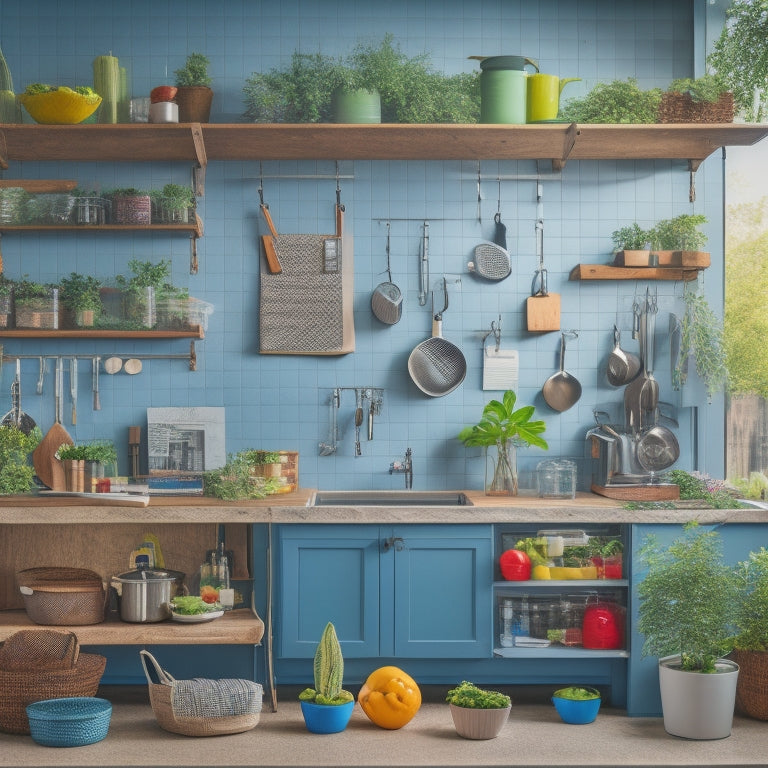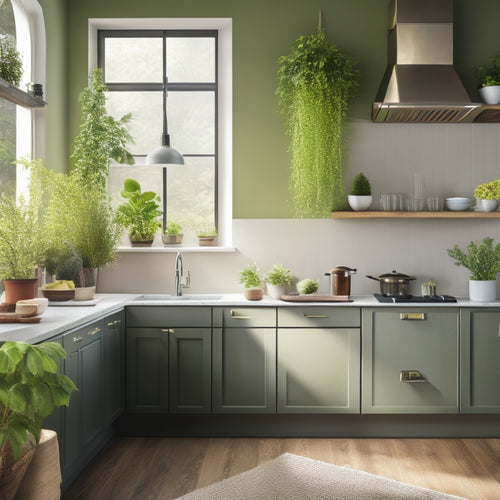
Master Your Kitchen With These Proven Productivity Tips
Share
You can master your kitchen by simplifying your workflow, optimizing storage, and creating a functional layout. Start by streamlining your kitchen's workflow by eliminating clutter, assigning a home for each item, and establishing a consistent cleaning routine. Next, maximize storage spaces by utilizing corners, countertops, and vertical spaces. Declutter your counters by keeping only essentials and organizing decor and storage items. To save time, prep ingredients in advance, plan meals, and consider batch cooking. By implementing these proven productivity tips, you'll be well on your way to a more efficient kitchen - and get ready to discover even more secrets to a stress-free cooking experience.
Key Takeaways
• Simplify your kitchen workflow by eliminating clutter, assigning a home for each item, and establishing a consistent cleaning routine.
• Optimize storage spaces by maximizing corner cabinet and countertop space, and utilizing organizing essentials like utensil organizers and spice racks.
• Create a functional kitchen layout by focusing on efficient appliance placement, considering functional kitchen islands, and planning for smooth traffic flow.
• Streamline meal preparation time by prepping ingredients in advance, engaging in meal planning, and considering batch cooking for efficient use of ingredients.
• Maximize vertical storage capacity by utilizing wall-mounted shelves, hooks, and baskets, and keeping frequently used items within easy reach.
Simplify Your Kitchen Workflow
To optimize your kitchen's productivity, start by streamlining your workflow by eliminating clutter, assigning a home for each item, and establishing a consistent cleaning routine. This foundation will enable you to implement time-saving techniques that'll have you cooking like a pro in no time.
Invest in organizing essentials like a utensil organizer, spice rack, and a pegboard for frequently used items. These tools will help you stay focused and avoid wasting time searching for misplaced items.
Next, incorporate efficiency hacks into your daily routine. For instance, prep ingredients in advance, use a 'mise en place' approach, and cook in bulk to reduce meal prep time. Leverage kitchen gadgets like a stand mixer, food processor, or Instant Pot to simplify tasks and free up time for more creative pursuits.
Optimize Your Storage Spaces
You can greatly enhance your kitchen's efficiency by maximizing every inch of storage space, from corner cabinets to countertops, to guarantee everything has a designated spot. By doing so, you'll reduce clutter, save time, and create a more efficient cooking environment.
Start by organizing your pantry: categorize items by type, and store them in airtight containers or baskets to maintain freshness and visibility. Next, utilize cabinet space by installing shelves, baskets, or racks to store cookware, utensils, and spices. This will keep your countertops clear and allow you to access what you need quickly.
Consider investing in a pegboard or hooks for hanging frequently used items, like pots, pans, or utensils. Additionally, label each storage area to make sure you and others can easily find what they need. By optimizing your storage spaces, you'll be able to focus on cooking, rather than searching for misplaced items. This will give you more control over your kitchen and allow you to tackle meal prep with confidence.
Create a Functional Layout
Design your kitchen layout to flow like a well-coordinated dance, where every step and movement is deliberate and efficient, saving you time and energy as you cook and prepare meals.
To achieve this, focus on efficient appliance placement. Position your most frequently used appliances in easy-to-reach locations, minimizing the need for excessive movement. Contemplate installing functional kitchen islands that provide additional counter space and storage, while also defining different zones within the kitchen.
When designing your layout, don't forget to take into account traffic flow. You want to create a smooth, uninterrupted path through the kitchen, avoiding narrow walkways and tight corners. By doing so, you'll reduce congestion and make it easier to navigate the space.
Designing for ease means thinking about how you'll move through the kitchen, not just how you'll use each individual component. By keeping these principles in mind, you'll create a kitchen layout that's both functional and efficient, allowing you to cook and prepare meals with ease and confidence.
Declutter Your Kitchen Counters
Cluttered kitchen counters can suffocate your cooking creativity, making it challenging to focus on the culinary masterpiece at hand. To regain control, decluttering your kitchen counters and adopting a more organized approach is crucial. Embracing minimalist aesthetics can help you achieve a sense of calm and clarity in your cooking space.
Here's a simple framework to get you started:
| Category | Items to Keep | Items to Remove |
|---|---|---|
| Cooking Essentials | Frequently used utensils, oils, and spices | Infrequently used gadgets, expired ingredients |
| Food Preparation | Cutting boards, mixing bowls, and colander | Cluttered cookbooks, unnecessary paper towels |
| Decor and Storage | A few decorative items, storage containers | Unused decorative items, cluttered storage bins |
Streamline Meal Preparation Time
Time efficiency in the kitchen hinges on a well-orchestrated meal preparation process, allowing you to cook with confidence and precision. By implementing time-saving techniques, you'll be able to whip up a delicious meal in no time.
One efficient cooking method is to prep ingredients in advance. Chop vegetables, marinate proteins, and cook grains ahead of time to save precious minutes during meal assembly.
Meal planning is another key component of streamlined meal preparation. Take some time each week to plan out your meals, make a grocery list, and shop for ingredients. This will help you avoid last-minute takeout runs and reduce food waste.
Consider batch cooking, where you prepare large quantities of a single ingredient or meal component. This approach not only saves time but also allows you to reuse ingredients throughout the week.
With a little planning and prep, you'll be able to cook a variety of meals quickly and efficiently, freeing up more time for the things you enjoy.
Maximize Vertical Storage Capacity
By utilizing wall-mounted shelves, hooks, and baskets, you can access valuable storage space in your kitchen, keeping frequently used items within easy reach while keeping countertops clear. This is especially important for small kitchens where every inch counts.
Installing hooks near your cooking station allows you to hang frequently used utensils, such as pots, pans, and kitchen tools, making them easily accessible. This not only saves time but also reduces clutter on your countertops.
Additionally, consider using stackable containers to store dry goods, spices, or cooking supplies. Labeling these containers will help you quickly identify what's inside, saving you time and effort.
By maximizing your vertical storage capacity, you'll be able to find what you need quickly, stay focused on your cooking, and maintain a sense of control in your kitchen.
Establish a Cleaning Routine
As you've optimized your kitchen's storage capacity, now it's time to turn your attention to maintaining its cleanliness and organization with a routine that'll keep your kitchen running like a well-oiled machine. Establishing a cleaning routine will help you stay on top of messes, reduce stress, and guarantee your kitchen remains a haven for cooking and entertaining.
To get started, break down your cleaning tasks into daily, weekly, and monthly chores. This will help you stay focused and avoid feeling overwhelmed. Here's a sample routine to get you started:
| Frequency | Task |
|---|---|
| Daily | Wipe down countertops, sink, and stove after meals |
| Weekly | Deep clean high-traffic areas, tidy up living spaces |
| Bi-Weekly | Organize supplies, restock essentials |
| Monthly | Deep clean appliances, scrub floors |
| Quarterly | Purge expired or unused items, reorganize storage |
Remember to schedule regular deep cleaning sessions to tackle stubborn messes and grime. By incorporating organizing supplies into your routine, you'll guarantee everything has its designated place, making cooking and cleaning a breeze. With a solid cleaning routine in place, you'll be able to maintain your kitchen's organization and cleanliness with ease.
Frequently Asked Questions
How Do I Maintain My Kitchen's Organization Over Time?
To maintain your kitchen's organization over time, you'll need to prioritize kitchen storage and time management. You're doing great so far, but it's essential to set aside time each week to maintain your space and adjust your storage as needed.
Can a Small Kitchen Still Be Highly Productive?
Like a master conductor, you can orchestrate a symphony of efficiency in even the smallest kitchen, maximizing space and streamlining workflow to create an efficient culinary machine that hums with productivity.
What Are the Best Kitchen Tools for Beginners?
You'll want essential gadgets like a chef's knife, cutting board, and pots to master basic cooking techniques, such as chopping, sautéing, and simmering, to whip up delicious meals with ease and confidence.
How Often Should I Reorganize My Kitchen Layout?
You're constantly rotating seasonal ingredients, swapping cooking styles, and adapting to new recipes, so you should reassess your kitchen layout every 3-6 months to maximize kitchen efficiency and layout improvement.
Are Kitchen Productivity Tips Applicable to Other Rooms?
You'll find that kitchen productivity tips translate well to other rooms, like your office, where streamlining tasks boosts productivity, and even your bathroom, where smart organization saves time and reduces stress.
Related Posts
-

3 Essential Steps to a Clutter-Free Kitchen
You'll reach a clutter-free kitchen by following three essential steps. First, purge and declutter by gathering items...
